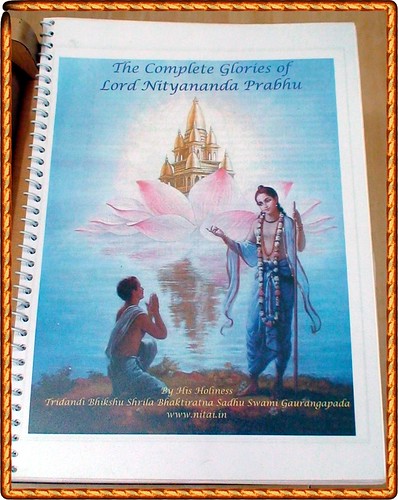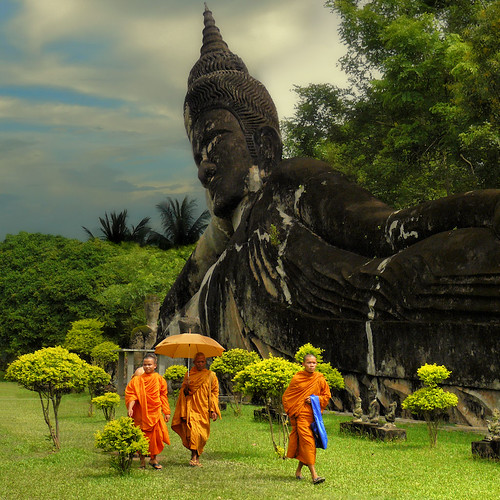Swami Paramahamsa Nithyananda, who was arrested in Himachal Pradesh and now undergoes his ‘spiritual seclusion’ under police custody in Karnataka, is now reported to be a ‘lover of wildlife’, as he is fond of skins/ hides of wild animals such as tigers, leopards, spotted deer and wild dogs.
Nithyananda, now credited with fancy titles such as Swami Sexananda, Sex Swami, and many other names, used to tell his followers, “I am Lord Shiva”, “I am Lord Krishna”, etc. When I read these statements after he was made ‘enlightened’ by Lenin Karuppan, and sex videos on YouTube, I thought that he made such claims when he was under a divine trance. I had to make such a wild guess just because he earlier claimed that he was under a similar trance when he was served by Ranjitha, Gopika, and some other men and women, as some jealous TV channels and journalists reported.
I have the bad habit of Googling up every thing, when I find myself in unknown territories such as California sex, Tantric sex, Bidadi sex, so on and so forth. My search led me to the Wikipedia page that said, “Nityananda (Sanskrit: nitya, eternal + ananda, bliss) may refer to:
Nityananda, the Vaishnava saint (born 1474 CE),
Bhagawan Nityananda, the Ganeshpuri Guru (1897-1961),
Mahamandaleshwar Nityananda, Mahamandaleshwar of the Mahanirvani Akhara, Haridwar India, disciple of Muktananda of Siddha Yoga,
Nitya Anand, a scientist,
Swami Nithyananda (Dhyanapeetam), Alleged Sex scandal figure and spiritual Guru from Thiruvannamalai, Tamil Nadu (1978–)”.
My attention was caught by “Alleged Sex scandal figure and spiritual Guru from Thiruvannamalai, Tamil Nadu…”, because that had something to do with what I read in the news. My search also ‘enlightened’ me on Tantric Sex Rites. It is one of the most organic things, as ‘the male partner visualizes himself as Shiva and the female partner visualizes herself as Shakti. Now I understood why he often said, “I am Lord Shiva”, and the name Gopika to ‘I am Lord Krishna’. Also, I came across two pages of what people call a Tantric Sex agreement in which they agree to undergo all kinds of sexcapades and also not to disclose their divine experiences to anyone, else they might encounter instant Samadhi. “A few dots in the eternal ocean of love and oneness with the universal conscience”!
Now I am convinced that Sun TV, Lenin Karuppan, Douglas McKeller of San Jose (US) and the Karnataka Police talk about the same Nithyananda, and not the four others listed above. So, I join the dots to see what figure emerges, though I do not expect a size zero. So, it emerges something as follows (sorry for any factual errors, your corrections and comments welcome!):
Secret Tantric Rituals have been going on in his Ashram, as the seized ‘sex agreements’ that were signed by the Tantric’s followers show. And that seems to be the reason why a top official of the Karnataka Police said that there is no evidence to prove rape or forced sex, and there is nothing in law to punish a swami who enjoyed sex with the consent of his partners. The videos uploaded by Sun TV and many others also do not show any ‘forced sex’. In fact, from the standards of what is shown in Indian cinema and popular TV shows, what Nithyananda does on the videos is just expressions of love. One can see more offending and obscene scenes in most of Indian films and TV serials. So, I wonder, what the big deal is! Some of my friends tell me that the godman misguided his devotees by assuring them that he is a celibate. Some others say that he was trading in Hinduism in wholesale and attributed all his dirty deals to Hinduism, the Vedic scriptures, and he even placed everything under the Nithya brand, like Nithya Yoga, Nithya sex, Nithya Temples, etc.
Then I came across Nithyananda’s biographer ('Glimpses of a Master', republished as 'Nithyananda' Vol 1: by Ram S Ramanathan, formerly Swami Advaithananda, who runs a business in Singapore), who was the speech writer, all other things he dispensed with his devotees, and his many volumes of biography. The biographer now distanced himself with Nithyananda, and says, “So, the so-called 'enlightenment' experience perhaps was a Tantric initiation from the Aghori babas. Certainly not one that would allow anyone to declare himself a Paramahamsa and initiate unsuspecting innocents into Sanyas and Brahmacharya… As his biographer, people have accused me of lying on all these facts including the birth-date. I have to accept those accusations as I was foolish to believe, as I was equally foolish to teach over a thousand people in turn to believe”.
So, I consider Nithyananda as a Tantric, who is trying to attain Tantric superpowers through Vamachara Tantra Rites, which are associated with the pancha-makara or the ‘Five Ms’, also known as the pancha-tattva’. These are Madya (wine, addictive substances like drugs, etc.), Mamsa (meat), Matsya (fish), Mudra (cereal), and Maithuna (sexual intercourse, all varieties and poses, but animals included or not, I do not know). In Vamachara or Vamamarga Tantric practices, most of the practitioners insist on the use of these ‘Five Ms’. These are props to make Tantra practitioners successful in their ‘quest for ‘Life Bliss’ and union with Param Shiva’. Because these practices are not approved of by most spiritualists and the cultured society, the Vamamarga Tantrics, Aghoris, and sects and cults like Kapalikas practice these rituals in utmost secrecy.
The props used in some extremely secret Tantric practices include cannibalism (eating human flesh), smearing the ash collected from burned dead bodies, using human skulls and bones, consuming various organs of animals like tigers, leopards, etc. which many people believe to have magic properties to cure diseases, defy aging, increase sexual endurance and pleasure, etc. And this is one of the reasons why the tiger population of countries like China has decreased to the level of extinction and there are large scale poaching and smuggling of tigers and their body parts to China and other countries.
Further, as most of us see in the posters and other visual representations of Gods and Goddesses, animals and animal parts like the tiger skin form essential items in their make-up and accessories. For instance, Lord Shiva wears leopard skin and many gods are depicted as seated on tiger skins. So, if a self-proclaimed ‘enlightened Paramahamsa Nithyananda’ who claims to be Shiva possess skins of tigers, leopards, etc., it only shows his Tantric origins. But the problem is with the legal restrictions and ethical questions on the possession and use of body parts of some of these wildlife species.
Swami Nithyananda, after his arrest in Himachal Pradesh, is now in police custody for his alleged involvement in several criminal cases relating to obscenity, criminal intimidation, rape and hurting religious sentiments. But now he seems to be a bit more in trouble following the recovery of a CD, which was seized from his Bidadi ashram. It has visuals of Swami Nithyananda using wildlife products including a tiger pelt, skin of a leopard, spotted deer and a wild dog.
"The CD is with forest officials. The swami will land in deep trouble if wildlife sleuths decide to investigate how and where he procured the wildlife products," said an official from the forest cell of the Karnataka CID. He added, neither the swami nor his ashram had declared any of the products that are seen in the CD.
Also, said an official, "We couldn't interrogate Swami Nithyananda as he went into hiding. But now that he has been arrested, we will go ahead with the case". And Additional Principal Chief Conservator of Forests B K Singh is reported to have said, "I'll ask my subordinates to proceed with the investigations. They will also be asked to get details of wildlife products found in the CD."
After reading these reports, one can understand the dilemma the officials face. The crimes alleged against the swami involve various departments of the Government. These reports simply suggest that there is no proper coordination between various departments. For example, “local forest officials who are probing the case were reluctant to comment”, a report said.
If Nithyananda went into hiding it was the wisest thing he could do to save his life, because violent mobs vandalized his Ashram and set many things on fire, when his sex tapes were aired. The police just failed to protect him and his Ashram. After all, he is just an ordinary mortal, though he claims to be Lord Shiva, Lord Krishna, etc. But, they are just jargons of his trade, just as some politicians, actors, cricket czars, etc. say blatant lies to the public to promote their businesses.
For example, what I viewed on video about former Andhra Governor Narayan Dutt Tiwari is more ridiculous than what Nithyananda did with the actresses and others. The 84-year-old N D Tiwari was shown in bed with three women by Telugu language cable news channel ABN Andhra Jyothi, though he said that he ‘is framed’ and ‘it is a political conspiracy’. But, no one vandalized anything of Tiwari, nor was he jailed. He did everything for pure BLISS of his own enjoyment, but if Paramahamsa Nithyananda did every thing for saving the humanity from calamities like earthquakes around the Pacific Ring of Fire (work in progress in his Malaysian and Singapore Ashrams in the Pacific Ring), and he was about to stop the Icelandic volcano Eyjafjallajökul from erupting when Douglas McKeller of San Jose, California put a stop to it by claiming ‘California Sex’ is ineffective, even if each participant has to shell out $400,000 for participation and a certificate of enlightenment.
Geetanjali V, Deputy Conservator of Forests (Ramanagar Division) was more concerned about the violations as she said, "Earlier, sandalwood pellets were also recovered from the swami's ashram. We'll conduct an investigation in that case. However, to take appropriate action in case of other wildlife products the swami is evidently seen with, we'll require orders from higher authorities."
But Nithyananda, though Tantric rites may need animal skins, don’t you think that it is only common sense to respect the laws of the country that you live in and by selling the Vedic wisdom of that country you made several millions and as such all your godly programs have to be redesigned to respect the laws and the sentiments of the people? After all, all well-meaning religions, including Hinduism, consider that animals too are creations of God, and they too need to be loved and cared for. You cannot get skins of animals unless you (or others) kill them for your petty, fanciful “Bliss” programs!
I think I am more confused about the business of BLISS through animals! But, where are the animal rights activists and PETA? The law seems to be helpless! For Nithyananda, enhancing ‘Nithyanandam’ for his dollar-spinning followers is more of a thing of union with universal consciousness and enriching the lives of his inmates than kindness to animals, and being a responsible law-abiding citizen!








